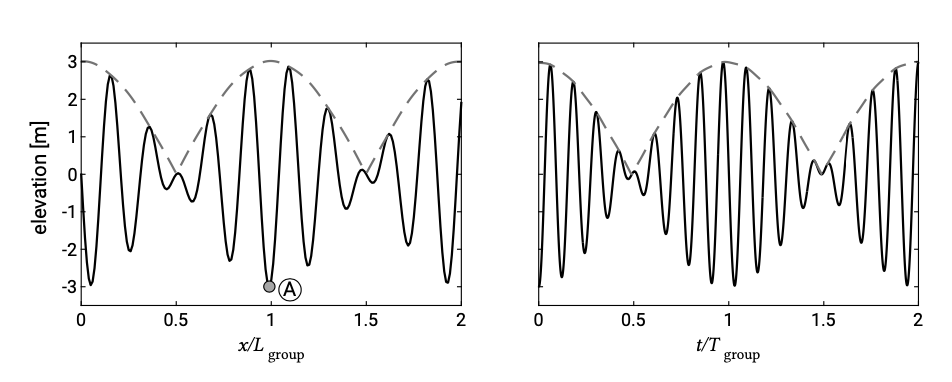3.5.3: Wave groups
- Page ID
- 16295
Another interesting phenomenon in deep water waves is that the wave crests move faster than the wave energy. Let us first consider a series of regular waves moving away from a disturbance into otherwise still water. You can think of a group of waves generated by a wave board in wave flume and now moving away from the wave board. It can be seen that the wave front and the group of waves as a whole moves at a certain speed. This speed is called the group speed and is the speed with which the energy of the waves moves. The phase velocity however was defined as the velocity of a wave crest. When following a wave crest we can see how it originates at the rear of the group, then moves forward through the group and finally disappears at the leading-edge of the group. The phase velocity of the wave crest is therefore larger than the velocity of the wave front or the group (except in shallow water where the group velocity is equal to the phase velocity).

Now we look at irregular waves. They appear more or less in groups so that we now have a series of groups as opposed to the one group as described above. The groupiness is caused by interference between waves of different wavelength. To demonstrate this, consider the limiting case of just two slightly different frequencies travelling in the same direction. We have a water depth of 20 m and two regular waves with an amplitude of 1.5 m each. The wave periods are 6.2 s and 7.0 s respectively. The two wave trains will interfere with each other as shown in Fig. 3.11. The length and period of the groups can be computed from the differences in wavenumbers and frequencies respectively:
\[k_{group} = \Delta k = k_2 - k_1 \to L_{group} = \dfrac{2\pi}{\Delta k}\]
\[\omega_{group} = \Delta \omega = \omega_2 - \omega_1 \to T_{group} = \dfrac{2\pi}{\Delta \omega}\]
The broader the spectrum is the more irregular the waves are and the less clear the groups can be distinguished. Because of the narrow spectrum grouping is prominent in swell (see Sect. 3.5.4) and more pronounced if the swell is dispersed more. As in the case of the disturbance, the energy of waves is carried in the group and not in each individual wave.
The ratio between the group velocity and the higher phase velocity is called \(n\) and reads according to Airy wave theory:
\[n = \dfrac{c_g}{c} = 0.5 \left (1 + \dfrac{2kh}{\sinh 2kh} \right ) \]
Figure 5.3 shows the dependency of \(n\) on the water depth and (deep water) wavelength. For short waves in deep water \(n\) reduces to 0.5. The group velocity therefore is half of the propagation velocity of an individual wave crest. When calculating how long it will take for a group of swell waves to cover a certain distance the group velocity needs to be taken into account. For long waves (or shallow water) \(n\) equals 1 such that the phase velocity is equal to the group velocity. The frequency dependency of the group velocity is comparable to that of the phase velocity. Hence, the fronts of longer period waves travel faster.
In Sect. 3.4.4 we had already seen that the energy per square metre of water surface is \(E= \tfrac{1}{8} \rho g H_{rms}^2\). This energy is propagated at the wave group speed \(c_g\), thus causing an energy flux \(U\), with
\[U = E c_g = Enc\]
Based on energy conservation, offshore wave conditions can be translated to the nearshore. The energy balance therefore is an important concept in coastal engineering. It is dis- cussed in detail in Ch. 5.


